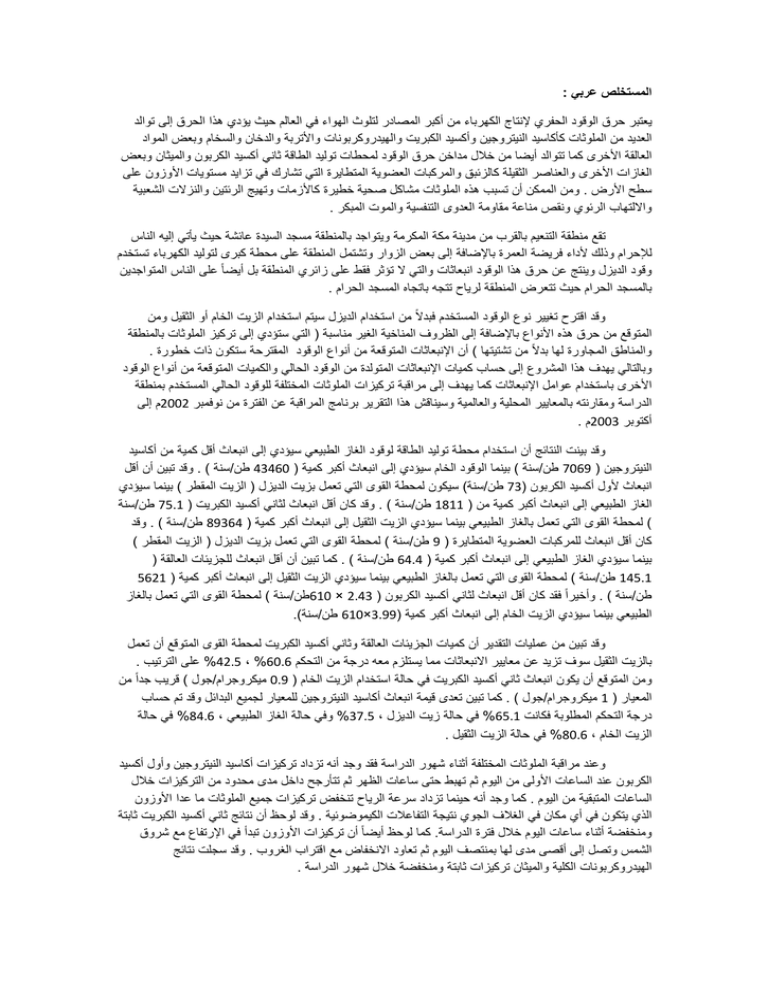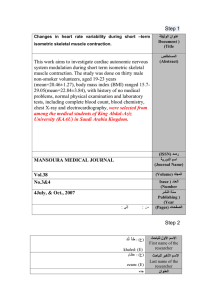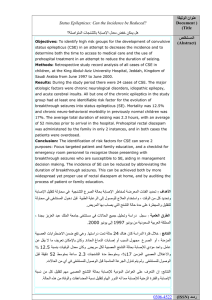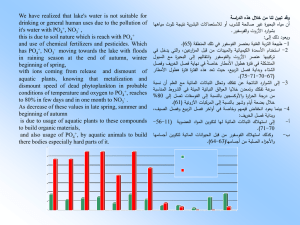30300.docx
advertisement

المستخلص عربي : يعتبر حرق الوقود الحفري إلنتاج الكهرباء من أكبر المصادر لتلوث الهواء في العالم حيث يؤدي هذا الحرق إلى توالد العديد من الملوثات كأكاسيد النيتروجين وأكسيد الكبريت والهيدروكربونات واألتربة والدخان والسخام وبعض المواد العالقة األخرى كما تتوالد أيضا من خالل مداخن حرق الوقود لمحطات توليد الطاقة ثاني أكسيد الكربون والميثان وبعض الغازات األخرى والعناصر الثقيلة كالزئبق والمركبات العضوية المتطايرة التي تشارك في تزايد مستويات األوزون على سطح األرض .ومن الممكن أن تسبب هذه الملوثات مشاكل صحية خطيرة كاألزمات وتهيج الرئتين والنزالت الشعبية وااللتهاب الرئوي ونقص مناعة مقاومة العدوى التنفسية والموت المبكر . تقع منطقة التنعيم بالقرب من مدينة مكة المكرمة ويتواجد بالمنطقة مسجد السيدة عائشة حيث يأتي إليه الناس لإلحرام وذلك ألداء فريضة العمرة باإلضافة إلى بعض الزوار وتشتمل المنطقة على محطة كبرى لتوليد الكهرباء تستخدم وقود الديزل وينتج عن حرق هذا الوقود انبعاثات والتي ال تؤثر فقط على زائري المنطقة بل أيضا على الناس المتواجدين بالمسجد الحرام حيث تتعرض المنطقة لرياح تتجه باتجاه المسجد الحرام . وقد اقترح تغيير نوع الوقود المستخدم فبدال من استخدام الديزل سيتم استخدام الزيت الخام أو الثقيل ومن المتوقع من حرق هذه األنواع باإلضافة إلى الظروف المناخية الغير مناسبة ( التي ستؤدي إلى تركيز الملوثات بالمنطقة والمناطق المجاورة لها بدال من تشتيتها ) أن اإلنبعاثات المتوقعة من أنواع الوقود المقترحة ستكون ذات خطورة . وبالتالي يهدف هذا المشروع إلى حساب كميات اإلنبعاثات المتولدة من الوقود الحالي والكميات المتوقعة من أنواع الوقود األخرى باستخدام عوامل اإلنبعاثات كما يهدف إلى مراقبة تركيزات الملوثات المختلفة للوقود الحالي المستخدم بمنطقة الدراسة ومقارنته بالمعايير المحلية والعالمية وسيناقش هذا التقرير برنامج المراقبة عن الفترة من نوفمبر 2002م إلى أكتوبر 2003م . وقد بينت النتائج أن استخدام محطة توليد الطاقة لوقود الغاز الطبيعي سيؤدي إلى انبعاث أقل كمية من أكاسيد النيتروجين ( 7069طن/سنة ) بينما الوقود الخام سيؤدي إلى انبعاث أكبر كمية ( 43460طن/سنة ) .وقد تبين أن أقل انبعاث ألول أكسيد الكربون ( 73طن/سنة) سيكون لمحطة القوى التي تعمل بزيت الديزل ( الزيت المقطر ) بينما سيؤدي الغاز الطبيعي إلى انبعاث أكبر كمية من ( 1811طن/سنة ) .وقد كان أقل انبعاث لثاني أكسيد الكبريت ( 75.1طن/سنة ) لمحطة القوى التي تعمل بالغاز الطبيعي بينما سيؤدي الزيت الثقيل إلى انبعاث أكبر كمية ( 89364طن/سنة ) .وقد كان أقل انبعاث للمركبات العضوية المتطايرة ( 9طن/سنة ) لمحطة القوى التي تعمل بزيت الديزل ( الزيت المقطر ) بينما سيؤدي الغاز الطبيعي إلى انبعاث أكبر كمية ( 64.4طن/سنة ) .كما تبين أن أقل انبعاث للجزيئات العالقة ( 145.1طن/سنة ) لمحطة القوى التي تعمل بالغاز الطبيعي بينما سيؤدي الزيت الثقيل إلى انبعاث أكبر كمية ( 5621 طن/سنة ) .وأخيرا فقد كان أقل انبعاث لثاني أكسيد الكربون ( 610 × 2.43طن/سنة ) لمحطة القوى التي تعمل بالغاز الطبيعي بينما سيؤدي الزيت الخام إلى انبعاث أكبر كمية ( 610×3.99طن/سنة). وقد تبين من عمليات التقدير أن كميات الجزيئات العالقة وثاني أكسيد الكبريت لمحطة القوى المتوقع أن تعمل بالزيت الثقيل سوف تزيد عن معايير االنبعاثات مما يستلزم معه درجة من التحكم %42.5 ، %60.6على الترتيب . ومن المتوقع أن يكون انبعاث ثاني أكسيد الكبريت في حالة استخدام الزيت الخام ( 0.9ميكروجرام/جول ) قريب جدا من المعيار ( 1ميكروجرام/جول ) .كما تبين تعدى قيمة انبعاث أكاسيد النيتروجين للمعيار لجميع البدائل وقد تم حساب درجة التحكم المطلوبة فكانت %65.1في حالة زيت الديزل %37.5 ،وفي حالة الغاز الطبيعي %84.6 ،في حالة الزيت الخام %80.6 ،في حالة الزيت الثقيل . وعند مراقبة الملوثات المختلفة أثناء شهور الدراسة فقد وجد أنه تزداد تركيزات أكاسيد النيتروجين وأول أكسيد الكربون عند الساعات األولى من اليوم ثم تهبط حتى ساعات الظهر ثم تتأرجح داخل مدى محدود من التركيزات خالل الساعات المتبقية من اليوم .كما وجد أنه حينما تزداد سرعة الرياح تنخفض تركيزات جميع الملوثات ما عدا األوزون الذي يتكون في أي مكان في الغالف الجوي نتيجة التفاعالت الكيموضوئية .وقد لوحظ أن نتائج ثاني أكسيد الكبريت ثابتة ومنخفضة أثناء ساعات اليوم خالل فترة الدراسة .كما لوحظ أيضا أن تركيزات األوزون تبدأ في اإلرتفاع مع شروق الشمس وتصل إلى أقصى مدى لها بمنتصف اليوم ثم تعاود االنخفاض مع اقتراب الغروب .وقد سجلت نتائج الهيدروكربونات الكلية والميثان تركيزات ثابتة ومنخفضة خالل شهور الدراسة . وقد تأرجحت اتجاهات الرياح خالل شهور الدراسة فأثناء شهر نوفمبر كان اتجاه الرياح للشمال وأثناء شهور ديسمبر ويناير ومايو كانت الرياح متجهة للشمال يليها الجنوب أما أثناء شهور فبراير ومارس وأبريل ويونيه ويوليه وأغسطس وسبتمبر فقد كان اتجاه الرياح بين الجنوب والجنوب الشرقي وأخيرا فأثناء أكتوبر كان اتجاه الرياح بين الشرق والشمال الشرقي . وقد بينت العالقة اإلحصائية بين الملوثات المختلفة أثناء معظم شهور الدراسة أنه يوجد عالقة موجبة قوية بين األوزون وأكسيد النيتروجين المتلفة كما وجدت عالقة موجبة ضعيفة بين األوزون ودرجة الحرارة وعالقة سالبة متوسطة مع ثاني أكسيد الكبريت كما وجدت عالقة موجبة متوسطة بي ثاني أكسي الكبريت و أكاسيد النيتروجين المختلفة وأول أكسيد الكربون . وعند مقارنة النتائج التي تم الحصول عليها من خالل القياسات مع المعايير فقد تبين أن كل نتائج أول أكسيد الكربون وثاني أكسيد النيتروجين وثاني أكسيد الكبريت التي سجلت تتفق مع المعايير بينما تعدت بعض نتائج األوزون بعض المعايير وقد كان مدى نتائج أكاسيد النيتروجين صغير مما يستبعد معه وجود أي خطورة كما تبين عدم وجود معايير لمقارنة نتائج كال من الهيدروكربونات الكلية والميثان لتحديد مطابقتها . وعند إجراء المقارنة االقتصادية بين أنواع الوقود المختلفة المقترحة فقد وجد أن المقارنة السريعة لتكلفة الوقود فقط قد رجحت استخدام وقود الزيت الثقيل ووقود الزيت الخام نظر لرخص تكلفتهم ولكن عند جمع تكلفة الوقود وتكلفة وحدات التحكم في الملوثات التي ستنتج عنهم والتكاليف األخرى الغير ملحوظة والغير مرئية والتي لم تتوفر بياناتها نظرا لصعوبة الحصول عليها أو ألنها عوامل كيفية لم يتم رصد تكلفة لها فإنه يؤكد االقتراح باستخدام وقود الغاز الطبيعي يليه وقود الديزل في حالة صعوبة استخدام األول . وعند استخدام نموذج جوسان لتقدير تركيزات الملوثات المنبعثة من محطة مكة للقوى عند درجات مختلفة من الثبات وعند مدى من المسافات يصل إلى 10كيلومترات بينت النتائج أن تركيزات أكاسيد النيتروجين وثاني أكسيد الكبريت تتعدى المعايير عند مستوى ثبات أو أكثر وعند بعض المسافات لكل الوقود المقترحة ما عدا وقود الغاز الطبيعي مما يعني أن كل المناطق التي تقع داخل هذا المدى مع أخذ اتجاه الرياح في االعتبار سوف تتأثر وقد كان الترتيب الثاني من ناحية قلة التعدي لوقود الديزل وهذا يؤكد اقتراح استخدام وقود الغاز الطبيعي ثم وقود الديزل إذا وجد صعوبة في استخدام األول . وقد انتهى التقرير ببعض التوصيات والتي اشتملت على المراقبة المستمرة لتركيز اإلنبعاثات ،استخدام بعض طرق التحكم لإلنبعاثات التي تتعدى المعايير ،منع استخدام الزيت الثقيل أو الخام ،وفي حالة التغيير يجب اللجوء إلى استخدام الغاز الطبيعي بدال من زيت الديزل . Abstract: The burning of fossil fuels to produce electricity from the largest sources of air pollution in the world, This burning to the breeding of many pollutants Kokasid nitrogen and sulfur dioxide, hydrocarbons, dust, smoke, soot and some of the other outstanding as breed also through chimneys burning fuel for power plants carbon dioxide, methane and some other gases and heavy metals such as mercury and volatile organic compounds that participate in the increasing levels of ozone on the surface of the earth. It is possible that these pollutants cause serious health problems Kalozmat and irritation of the lungs, bronchitis, pneumonia and lack of immune resistance to respiratory infections and early death. Area is located smoothing near the city of Mecca, located in the region Mosque Aisha, where people come for ihraam in order to perform Umrah as well as some visitors and include the region to plant a major electricity generation using diesel fuel is produced from the burning of this fuel emissions, which affects not only the visitors to the region, but also on the people present in the Holy Mosque in the area exposed to the winds heading toward the Grand Mosque. It has been suggested to change the type of fuel used, instead of using diesel will use crude oil or heavy is expected from the burning of these types in addition to climatic conditions inappropriate (which will lead to the concentration of pollutants in the region and neighboring areas rather than dispersed) that emissions expected from the fuels proposed will be gravity. And therefore this project aims to calculate quantities of emissions generated from fuel the current and predicted amounts of other fuels using emission factors and aims to monitor the concentrations of various pollutants fuel the current user area of study and compare standards of local and global, will discuss this report, the monitoring program for the period from November 2002 to October 2003 . The results showed that the use of the power plant to natural gas fuel will result in the least amount of emissions of oxides of nitrogen (7069 tons / year), while the raw fuel emissions will lead to the largest amount (43 460 tons / year). Has been shown to lower emissions of carbon monoxide (73 tons / year) would be to station the forces that operate diesel oil (distillate oil), while natural gas will lead to the largest amount of emissions (1811 tons / year). It was less emissions of sulfur dioxide (75.1 tons / year) to station the forces that run on natural gas while the heavy oil will lead to the emission of the largest amount (89 364 tons / year). It was less emission of volatile organic compounds (9 tons / year) for the power plant operating diesel oil (distillate oil), while natural gas will lead to the emission of the largest amount (64.4 tons / year). As it turns out that less emission of suspended particles (145.1 tons / year) for the power plant by natural gas, while heavy oil will lead to the emission of the largest quantity (5621 tons / year). Finally, less emission of carbon dioxide (2.43 × 610 tons / year) for the power plant by natural gas, while crude oil will lead to the emission of the largest quantity (3.99 × 610 tons / year). The assessments found that the quantities of suspended particles and sulfur dioxide for the power plant is expected that heavy oil will exceed emission standards, which require a degree of control with 60.6%, 42.5%, respectively. It is expected that emissions of sulfur dioxide in the case of the use of crude oil (0.9 micrograms / Gul) is very close to the standard (1 microgram / Gul). As it turns out exceeds the value of the nitrogen oxides emission standard for all the alternatives have been calculated the degree of control required was 65.1% in the case of diesel oil, 37.5% in the case of natural gas, 84.6% in the case of crude oil, 80.6% in the case of heavy oil. And when you monitor various pollutants during the months of the study has found that increasing concentrations of nitrogen oxides and carbon monoxide in the early hours of the day and then fall until noon and then oscillate within a limited range of concentrations during the remaining hours of the day. Also found that when increasing the wind speed drops the concentrations of all pollutants except ozone, which consists of any place in the atmosphere as a result of interactions Alkimudoih. It was noted that the results of sulfur dioxide and low during the fixed hours of the day during the study period. It was also noted that ozone concentrations begin to rise with the sun and up to the maximum extent of its mid-day, and then falling with the approaching sunset. The recorded results of total hydrocarbons and methane concentrations and stable low during the months of the study. Has fluctuated wind directions during the months of the study During the month of November was the wind direction to the north and during the months of December and January and May was the wind heading to the North, followed by the south, either during the months of February and March, April, June and July and August and September was the wind direction between the south and south-east and finally During October was the wind direction between the east and north-east. Showed the statistical relationship between various pollutants during most months of the study that there is a positive relationship strong between ozone and nitrogen oxide damaged also found a positive relationship is weak between ozone and temperature and the relationship of negative medium with sulfur dioxide also found a positive relationship medium's second-tog sulfur and nitrogen oxides of various and carbon monoxide. When comparing the results obtained through measurements with the standards has been shown that all the results of carbon monoxide and nitrogen dioxide and sulfur dioxide recorded in accordance with the standards, while exceeding some of the results of ozone some of the standards was the results of oxides of nitrogen, a small, precluding him and there is no As it turns out the seriousness of the lack of criteria for comparing the results of both total hydrocarbons and methane to determine compliance. When an economic comparison between the types of fuel, the various proposed has been found that rapid comparison of the cost of fuel alone has suggested the use of heavy fuel oil, fuel oil, crude look of the cheap Tkfatthm but when you raise the cost of fuel and the cost of the controllers in the pollutants that produce them, and other costs subtle and invisible, which did not available data because of the difficulty in obtaining them or because they are not factors of how the cost of monitoring them, it reflects the proposal to use the fuel, followed by natural gas and diesel fuel in case of difficult to use first. When using the model Gosan to estimate the concentrations of pollutants emitted from the plant Mecca of the forces at different degrees of stability, when a range of distances up to 10 km results showed that the concentrations of nitrogen oxides and sulfur dioxide exceed the standards at a level of stability or more and at some distance of each fuel proposed, except fuel natural gas, which means that all areas that fall within this range, taking wind direction into account will be affected has been ranking second in terms of lack of infringement of diesel fuel, and this confirms the proposed use of fuel gas, diesel fuel if there is difficulty in the use of the first. The report ends with some recommendations which included the continuous monitoring of the concentration of emissions, the use of certain methods of control of emissions that exceed the standards, preventing the use of heavy oil or crude, in the case of change must resort to the use of natural gas instead of diesel oil. Of this study it became clear that the rates of growth and feed efficiency of birds fed 0.15% of the latency did not differ significantly from those resulting from birds fed the antibiotic was better morally than those recorded by a group Alkntrul was not for these additions natural adverse effect on the proportion of shelling or the proportion of the internal organs, while the use of green tea to the significant decrease in cholesterol content of meat.



